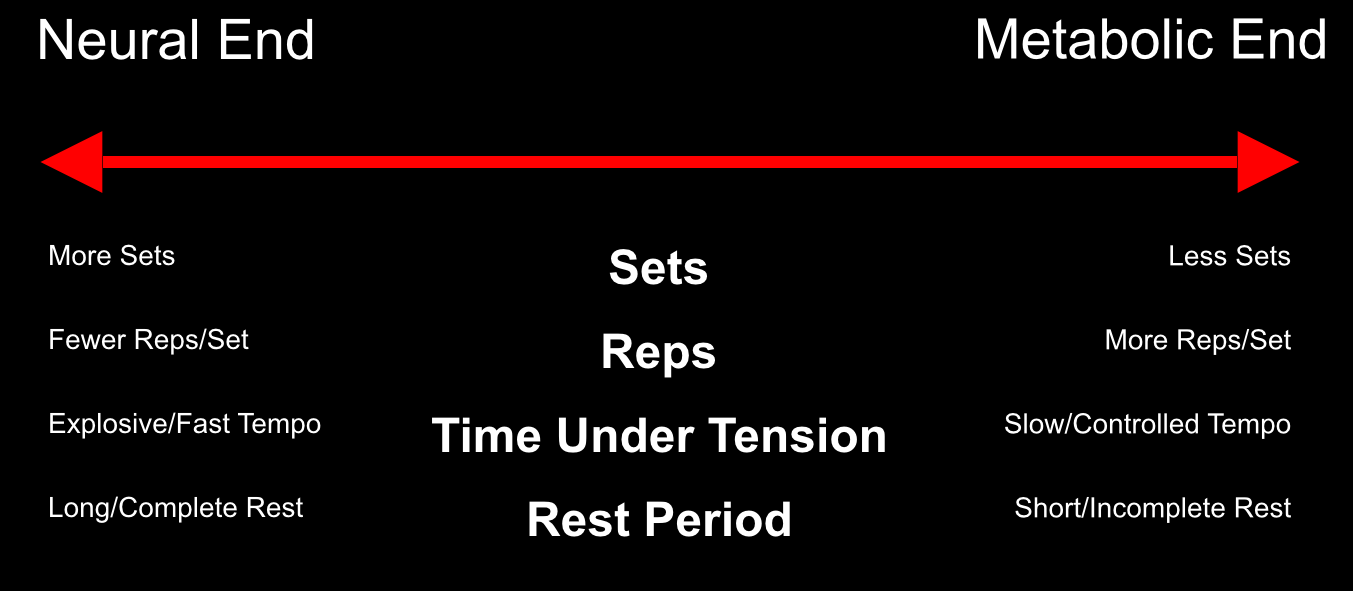Okay, finally back to answering reader questions – and this one is a doozy.
Honestly, if I had THE answer to this one, I’d be sitting on my private beach somewhere drinking protein shakes and reading training books.
But I digress.
The question for today is a simple one:
What set/rep scheme is best for size and strength?
Now when I read that, I could take it in a couple of directions:
- What set/rep scheme is best for size?
- What set/rep scheme is best for strength? OR
- What set/rep scheme is best if you want a blend of both?
To give you a thorough and complete answer, I’m going to answer the first two, and then pull it all together with the third.
An Intro to Sets and Reps
Sets and reps are the peanut butter-and-jelly of designing a program.
Sure you can have them in isolation, but they just work so darn well together!
If you’re new to all this, a repetition (or rep) is the lowering and raising of the weight one time. If you’re squatting, and go down and up one time, that’s one rep.
A set, then, is however many reps you decide to do before racking the weight and taking a break.
Sets and reps are typically noted in the following fashion:
Sets x Reps
(Unless of course you read Eastern Bloc texts, where they tend to flip-flop the too. Talk about confusion…)
Here are examples of different set/rep schemes:
- 3×10
- 2×20
- 5×5
- 6×3
As you’ll see, the sets and reps are inversely proportional to the other.
In other words, as the number of sets goes up, the number of reps goes down. And vice versa.
The key distinction with all of this is intensity, or how hard you’re working.
At the risk of boring you all with science, here’s a little graphic that explains the basic rules of program design:

Now that you have a basic understanding of training science, let’s look at how this applies to our goals of getting bigger, stronger, or both!
How to Get Bigger
If our goal is simply to get bigger, then we need to think about how a bodybuilder trains.
A bodybuilder is going to spend more time on the right-hand side of the continuum above.
Their program will often consist of the following:
- Fewer total sets for an exercise,
- More repetitions per set,
- A more moderate training intensity/load,
- Longer times under tension, and
- Shorter or incomplete rest in between sets.
Here are a couple examples of muscle-building set/rep schemes:
- 4×8
- 3×10
So how does this differ from a strength-focused training session?
How to Build Strength
Building strength resides on the opposite end of the neural-metabolic continuum.
A program that is focused on getting brutally strong tends to follow these rules:
- More total sets for an exercise,
- Fewer repetitions per set,
- A higher training intensity/load,
- Shorter times under tension, and
- Longer or more complete rest in between sets.
This is why you often see a powerlifter or Olympic lifter move a Herculean weight one or two times, and then rest for 4-5 minutes between sets.
The nervous system takes a long time to recover, so even if they feel rested, they may not be ready to perform at a high level yet.
Here are a couple examples of strength-building set/rep schemes:
- 5×5
- 6×3
So now we’ve got both ends of the spectrum covered. How do we go about blending the two?
How to Build BOTH
This is a great question, and the answer actually lies in how many elite bodybuilders and powerlifters train.
As you can imagine, there are benefits to both styles of training.
Size-building (or really, metabolic style training) is great for building muscle, shedding body fat, strengthening connective tissues, and a host of other things.
Strength-building workouts improve strength, speed and power, all while making our nervous system more efficient and effective.
So why choose between the two when you can have BOTH?
If you really want a blend of strength and size, it behooves you to go through phases of training where you emphasize both ends of the spectrum.
Do the high-rep work for a month or two to build a training foundation, build some muscle, and shed some body fat.
Then flip the script and do some heavy, bar-bending work.
This will make your nervous system more efficient, build some more muscle, and when you go back to the high-rep stuff you’re going to be able to move more weight as a result.
And if you look at how some of the best bodybuilders and powerlifters of all time trained, this is exactly what they did.

Ed Coan is arguably the greatest powerlifter of all time. And while a lot of his basic training was focused on sets of 5, he worked up to sets of 8 and 10 in the off-season to build his work capacity, muscle, etc.
Summary
I hope this article gives you some insight about how programs work, and how to build programs for strength, size or both.
Even if your goal isn’t to build the size of a Ronnie Coleman or the strength of an Ed Coan, once you understand the principles behind program design, you immediately become a better student of the game.
Good luck and good training!
0 Comments
Join the conversation